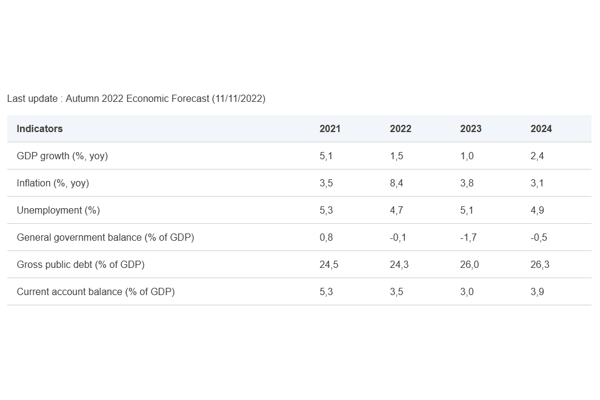 Credit: European Commission
Credit: European Commission
On Friday 11 November 2022, European Commission published the latest macroeconomic forecast for Luxembourg.
According to the report, Luxembourg's real GDP growth is projected to slow down to growth rates of 1.5% in 2022, 1% in 2023 and 2.4% in 2024, affected by weaker domestic and external demand, and high uncertainty surrounding consumers and investors’ behaviour. Headline inflation is forecast to increase to 8.4% this year, before decelerating to 3.8% in 2023 and further to 3.1% in 2024. The new measures to mitigate the impact of high energy prices and the economic slowdown will weigh on the general government balance, especially in 2023. Resulting deficits are projected to increase the general government debt-to-GDP ratio, although still at a low level.
Growth set to slow down in 2022 and 2023
The Commission noted that the real GDP increased by 2.2% in the first half of the year, compared to the same time period in 2021. Nevertheless, growth slowed sharply from 0.7% quarter-on-quarter in the first quarter (Q1) of 2022 to down 0.5% in 2022-Q2, driven by a decline in investment, in particular in construction, and a decrease in private consumption. In 2022 as a whole, GDP is expected to grow at 1.5% year-on-year.
Slowing demand in Luxembourg’s main trading partners and weakening financial outlook are forecast to weigh on the GDP growth in 2023, estimated to slow down to 1%. This is also reflected in the lower consumer and business confidence. In particular, the construction sector is set to slow down. Nevertheless, investment and private consumption are forecast to grow at a moderate level, despite rising interest rates expected to weigh on borrowing capacity and demand for mortgages in the country. Private consumption is projected to remain resilient, supported by additional measures introduced by the government in order to tackle high inflation and to maintain households’ purchasing power (‘Solidaritéitspak 2.0’). These measures include the stabilisation of electricity prices, limitation of the increase in gas prices to 15%, a reduction of heating oil prices and a 1% VAT cut until the end of 2023.
Positive prospects for 2024
Albeit subject to high uncertainty, European Commission sees better prospects for Luxembourg in 2024, with an estimated GDP growth rate of 2.4%. The economy is expected to return to its pre-pandemic trend, supported by growing investments and domestic and external demand.
Labour market set to remain resilient
The labour market is expected to remain resilient, although it is forecast to weaken slightly because of the economic slowdown. Unemployment is set to reach 4.7% this year, before increasing to 5.1% in 2023. The rise in unemployment is projected to remain subdued due to the high job vacancy rate and positive employment prospects in some sectors such as construction. With growth picking up, the unemployment rate is expected to decrease to 4.9% in 2024.
Fiscal support to lower inflation, however core inflation to edge up
Headline inflation is forecast to increase to 8.4% in 2022, mainly driven by energy prices. Nevertheless, energy price inflation is expected to moderate from 2022-Q4 until end 2023, easing inflationary pressures, due to the introduction of the ‘Solidaritéitspak 2.0’. Overall, Harmonised Index of Consumer Prices (HICP) is set to reach 3.8% in 2023, before decreasing to 3.1% in 2024. In turn, core inflation is forecast to rise from 4.7% in 2022 to 5% in 2023, reflecting higher wages and non-industrial goods’ prices. Wage increases are driven by two wage indexations expected to take place in 2023, including the one postponed from July 2022.
Support measures drive the decline in the general government balance
In 2022, the general government balance is expected to record a small deficit of 0.1% following the surplus of 0.8% of GDP in 2021. The government balance is projected to decrease as a result of lower GDP growth and the three government packages to support households and corporates facing higher energy prices. Revenue growth is expected to slow down from the high rate in 2021 but continues to benefit from the strong performance of taxes on products and imports, personal income tax and social contributions. The compensation of employees, social transfers and subsidies are pushing up expenditure growth in 2022. A main driver of this are the measures to mitigate the economic and social impact of high energy prices amounting to 1.2% of GDP. The high inflation impacts expenditure and revenue mainly via the wage indexation that pushes up social contributions, income tax, compensation of employees and social benefits. In addition, VAT revenues benefit from the increase in prices.
In 2023, the deficit is set to increase strongly to 1.7% of GDP. This is mainly caused by the additional government support measures of the ‘Solidaritéitspak 2.0’ mitigating the impact of high energy prices for households and corporates, but also due to the slowdown in economic activity and the uncertain prospects for financial markets. Revenue is expected to grow at a more moderate pace, because of the 1% VAT reduction, which is part of the household income support measures, and because corporate income tax is projected to be impacted by the economic and financial environment. Expenditure is expected to increase mainly driven by the energy measures (with an estimated budgetary impact of 1.0% of GDP), and the compensation of public employees due to the two wage indexations expected for 2023. In addition, public investment is planned to remain above 4% of GDP over the forecast horizon, supporting the green and digital transition, public infrastructure and housing.
The general government deficits are forecast to result in an upward trend of the debt-to-GDP ratio. The positive nominal GDP growth is expected to be offset by new debt issued to finance the deficit of the central government, as the surplus of the social security sector cannot be used for this purpose. Therefore, the debt-to-GDP ratio is projected to increase from 24.5% in 2021 to 26.3% in 2024.








